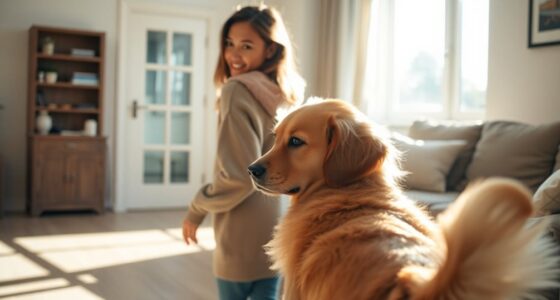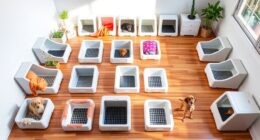Start by choosing a crate that fits your dog comfortably and place it in a quiet spot. Make the crate inviting with soft bedding and familiar toys, then encourage your dog to explore it with treats and praise, keeping the door open initially. Establish a consistent routine for crate time, gradually increase how long your dog stays inside, and monitor their reactions. Following these steps will help you train your dog successfully while creating a safe space—learn more to perfect each step.
Key Takeaways
- Choose an appropriately sized crate and place it in a quiet, comfortable area.
- Make the crate inviting with soft bedding, treats, and familiar scents.
- Introduce your dog gradually, encouraging curiosity with treats and positive reinforcement.
- Establish a consistent routine for crate time, meals, and walks to build predictability.
- Gradually increase crate duration while monitoring your dog’s comfort and adjusting as needed.
Choosing the Right Crate for Your Dog
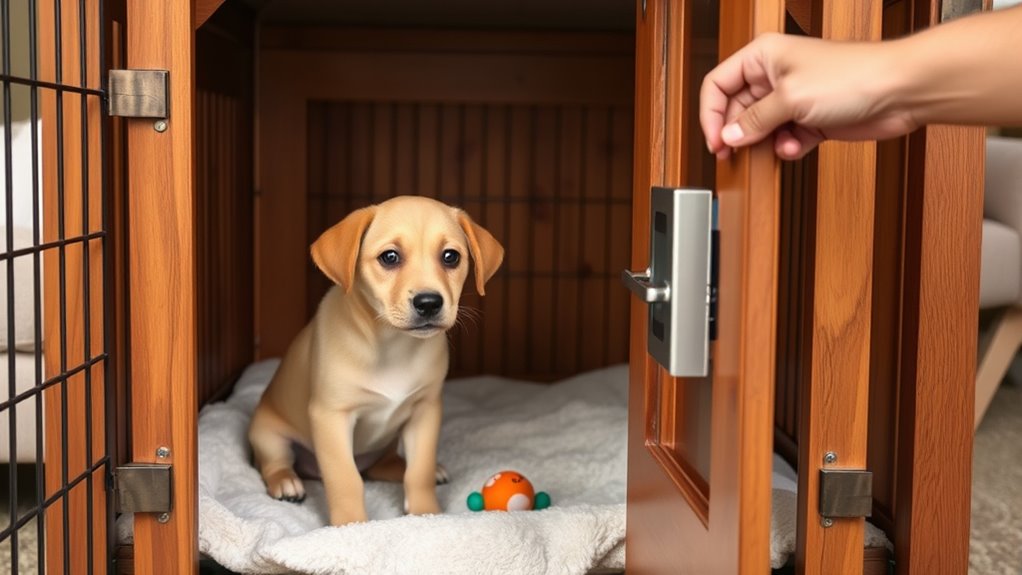
Choosing the right crate is essential to guarantee your dog feels comfortable and safe. Start by selecting the proper crate size. It should be large enough for your dog to stand, turn around, and lie down comfortably, but not so big that it encourages accidents inside. Measure your dog carefully to find the perfect fit. Next, consider material options. Popular choices include wire crates, which offer good ventilation and visibility, and plastic crates, which provide a cozy, enclosed space. Metal crates are durable, while fabric options are lightweight and portable. Your choice depends on your dog’s size, behavior, and how you plan to use the crate. Picking the right size and material ensures your dog feels secure and promotes successful crate training.
Making the Crate a Positive Space
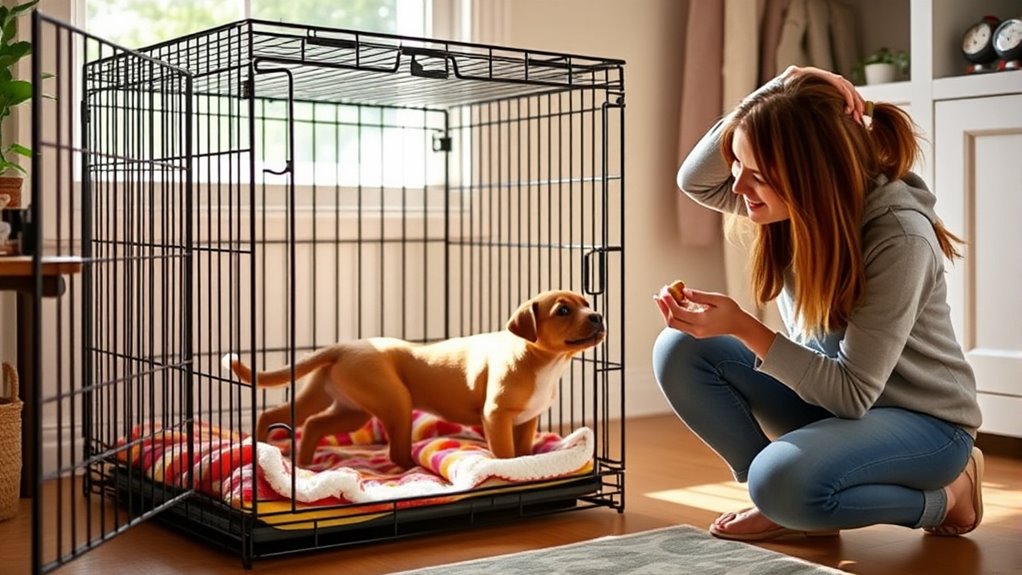
To help your dog view the crate as a safe and inviting space, start by making it comfortable and welcoming. Add soft bedding or blankets to boost crate comfort, ensuring it feels cozy and secure. Use items that carry familiar scents, like a worn towel or your dog’s favorite toy, to promote positive scent association. This helps your dog associate the crate with feelings of safety and calmness. Additionally, maintaining a positive environment inside the crate encourages your dog to see it as a peaceful retreat rather than a place of punishment. Keep the area clean and clutter-free, and avoid placing food or water inside initially, so the crate remains a peaceful retreat. By creating a warm, scent-rich environment, you set the foundation for your dog to see the crate as a positive, comforting space rather than a place to fear. Incorporating self watering plant pots can also enhance the training process by enabling secure log-ins and facilitating feedback. Understanding the importance of a comfortable, inviting space can significantly improve your dog’s crate training experience.
Introducing Your Dog to the Crate
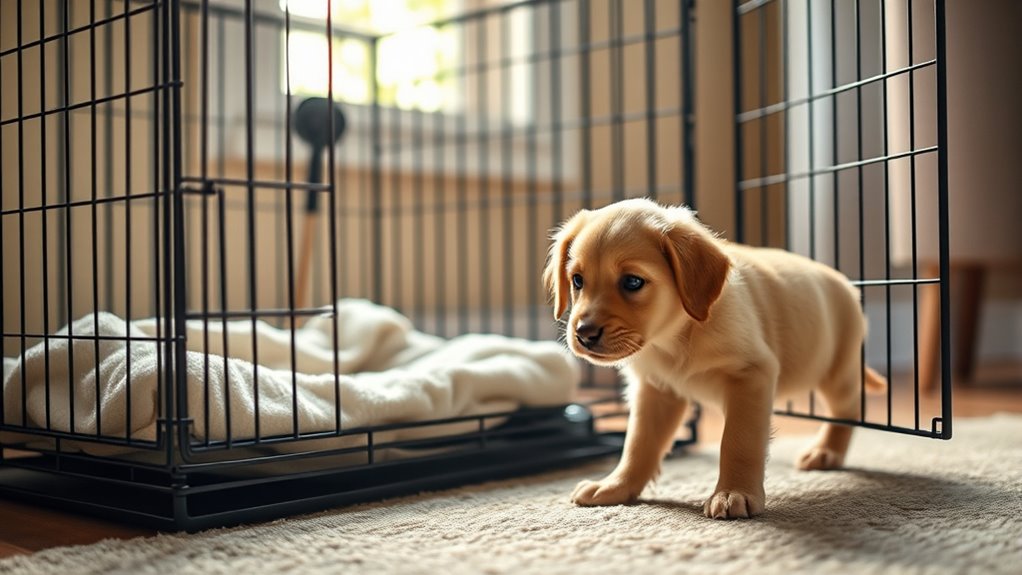
Before inviting your dog into the crate, let them become familiar with its presence. Begin by placing the crate in a quiet, comfortable spot with good crate placement—somewhere you spend time together. Make certain the crate size is appropriate: large enough for your dog to stand, turn around, and lie down comfortably. Don’t rush to open the door; instead, encourage curiosity by placing treats or toys nearby, letting your dog explore at their own pace. Use positive reinforcement to associate the crate with good things. Keep the door open initially, so your dog feels safe approaching it. This gradual introduction helps your dog see the crate as a welcoming space, setting the foundation for successful crate training. Understanding cybersecurity vulnerabilities can help you safeguard your digital assets during training sessions at home. Recognizing trust-building techniques is also essential to create a positive environment for your dog.
Establishing a Routine and Setting Boundaries

Once your dog is comfortable around the crate, it’s time to establish a consistent routine and clear boundaries. Incorporate crate time into your household routines so your dog knows when to expect it. Set specific times for crate sessions, meals, play, and walks to create predictability. Clear boundary setting helps your dog understand what behavior is acceptable around the crate. Avoid using the crate as a punishment; instead, associate it with positive experiences. Keep crate access limited during the day and avoid letting your dog roam freely in the crate area. Consistency is key—stick to the schedule and boundaries you set. This approach helps your dog feel secure and understand their place within your household routines. Establishing a training schedule ensures your dog learns expectations and builds confidence. Additionally, maintaining a consistent environment minimizes confusion and stress for your dog, reinforcing positive associations with the crate. Regularly reinforcing crate training with positive reinforcement techniques can further improve your dog’s comfort and trust. Incorporating educational toys into your training routine can also facilitate learning and reduce anxiety around the crate.
Gradually Increasing Crate Time and Monitoring Progress
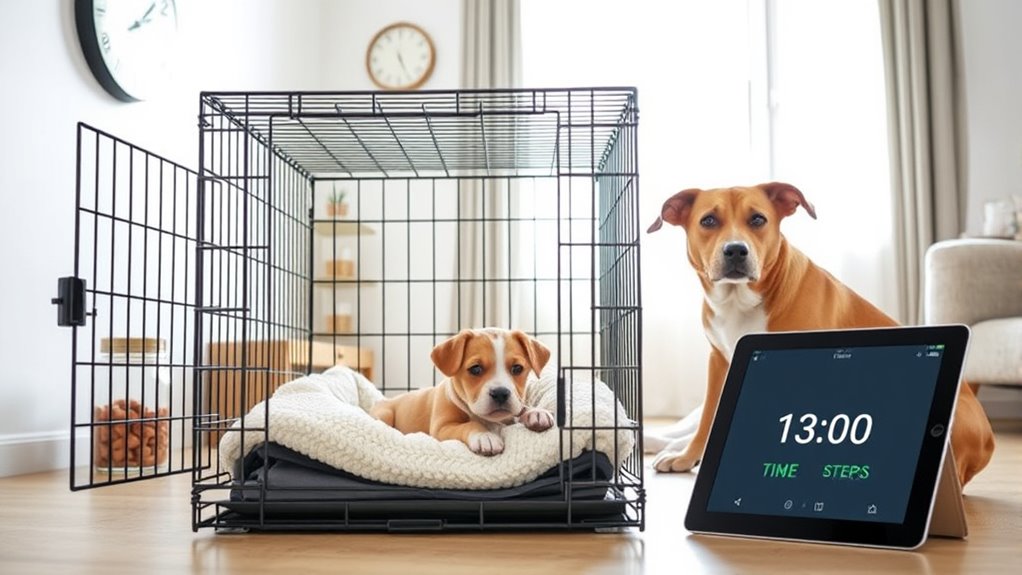
As your dog becomes more comfortable in the crate, it’s important to gradually increase the amount of time they spend inside. Start by adding a few minutes to their crate duration each day, observing how they respond. Consistently monitor their behavior and look for signs of stress or discomfort. Tracking your dog’s progress helps you determine when to extend crate time further or if you need to slow down. Keep a record of their reactions and crate duration to identify patterns and set realistic goals. Remember, patience is key; rushing this process can cause setbacks. Incorporating lifestyle adjustments such as proper routines can also support your dog’s comfort and adaptability. Recognizing behavioral cues during this process can further help in understanding your dog’s comfort level and readiness for longer crate periods. Additionally, understanding training principles can guide you in creating a positive crate environment that encourages gradual acceptance. Understanding detoxification and how it relates to your dog’s health can also help you tailor their crate training to promote overall wellness.
Frequently Asked Questions
How Do I Prevent My Dog From Developing Crate Anxiety?
To prevent your dog from developing crate anxiety, focus on creating a positive crate environment. Use treats and praise to make the crate inviting, and avoid forcing your dog inside. Practice training patience, gradually increasing crate time without punishment, so your dog associates it with safety and comfort. Consistency and gentle encouragement help build trust, ensuring your dog feels secure rather than anxious when in the crate.
What Are Signs My Dog Is Uncomfortable in the Crate?
Imagine your dog whines, paws at the crate, or shows tense body language—that’s a sign they’re uncomfortable. You might also notice vocal cues like barking or whimpering, indicating distress. If your dog avoids eye contact or tries to escape, it’s a clear signal of anxiety. Pay close attention to these signs, and adjust crate time gradually, ensuring your pup feels safe and secure rather than stressed.
Can Crate Training Help With Separation Anxiety?
Crate training can be a helpful separation anxiety solution, as it provides your dog with a safe, comfortable space. The benefits of crate training include reducing anxiety and establishing routines, which help your dog feel secure when you’re not around. Consistent crate training encourages positive associations, making it easier for your pup to manage separation stress. Over time, this approach can markedly improve your dog’s confidence and calmness when alone.
How Do I Choose the Right Size Crate for a Growing Puppy?
Imagine your puppy’s future size as a seed destined to grow. To choose the right crate size, consider current measurements and anticipate growth. A crate that’s too small can cause discomfort, while one too large might reduce your puppy’s sense of security. Opt for a crate that allows your puppy to stand, turn around, and stretch comfortably, ensuring it accommodates their growth and keeps them safe and cozy.
What Toys or Items Are Best to Include in the Crate?
You should include chew toys and comfort items in your puppy’s crate to make it inviting. Choose durable chew toys to keep their teeth healthy and prevent boredom. Add soft blankets or a favorite stuffed animal to provide comfort and a sense of security. Avoid toys with small parts that could be swallowed. These items help your puppy feel safe and relaxed, making crate training easier and more positive.
Conclusion
Think of crate training like planting a seed—you nurture it patiently, and with time, it blossoms into trust and comfort. When I first introduced my pup to the crate, she hesitated at first, but gradually, it became her safe haven. Remember, consistency and patience are your best tools. Before long, you’ll both see that a well-trained crate is like a cozy corner where your dog feels secure and happy.



